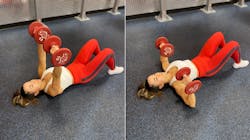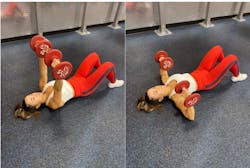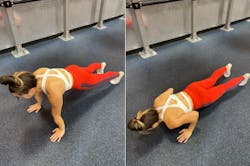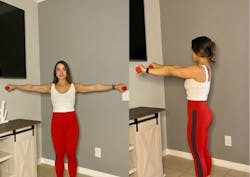Exercises that might cause more harm than good for dental pros
Dental professionals are known to have muscle imbalances. Unfortunately, repetitive movements and positions take a toll.1,2 Rounded shoulders, forward head, and elevated arms are just a few of the positions that negatively impact the body. As a result, some muscles become overworked and tight; others lengthen to the point that they become very weak or underactive.3,4
Exercise and strength training are tools to help correct muscle imbalances and improve posture.4 However, not all exercises are beneficial for dental professionals.5 Strengthening the muscles we use daily in dentistry can be counterproductive. A few of the muscles that tend to be overactive are the chest, upper traps, hip flexors, and lower back. The exercises listed below might place a dental professional in an unsafe place, causing injury or pain. If you are having consistent pain, you should check with a doctor to make sure no serious injuries are present.
8 safe and effective exercises for dental professionals
Poor ergonomics in dentistry: How to keep (or save) your career
5 yoga moves for career longevity
No. 1: Chest exercises (chest press, chest fly, push-up)
The chest muscles are often overactive and tight from being in a hunched-over position with rounded shoulders (figures 1–4).
No. 2: Rear cable pull-down
This exercise is done with a cable machine at a gym facility. This exercise can be harmful because it places the cervical spine in an unnatural position (figures 5 and 6).
No. 3: Specific shoulder exercises (lateral raise, front raise, upright row)
Your shoulder girdle muscles are delicate. Being selective about which exercises you perform is key. The exercises listed below primarily work the upper trapezius and the deltoids. These muscles are often overused from abducting the arms out to the sides and result in forward head posture, which is often seen in dental professionals while working on patients (figures 7–9).
No. 4: Cardio equipment selection
When selecting cardio machines or exercises, go for ones that keep you in an upright, vertical position versus a seated one. Dental clinicians are seated for most of the day, and the hip flexors tend to get tight.
Being aware of their body mechanics can help dental professionals' health and protect their career longevity—both inside and outside the office.
References
- Hayes MJ, Cockrell D, Smith DR. A systematic review of musculoskeletal disorders among dental professionals. Int J Dent Hyg. 2009;7(3):159-165. doi:10.1111/j.1601-5037.2009.00395.x
- Valachi B. Practice Dentistry Pain-Free: Evidence-Based Strategies to Prevent Pain and Extend Your Career. Posturedontics Press; 2008.
- Valachi B, Valachi K. Mechanisms leading to musculoskeletal disorders in dentistry. J Am Dent Assoc. 2003;134(10):1344-1350. doi:10.14219/jada.archive.2003.0048
- National Academy of Sports Medicine. Sutton BG, ed. NASM Essentials of Personal Fitness Training. 7th ed. Jones & Bartlett Learning; 2021.
- Durall C, Manske R, Davies G. Avoiding shoulder injury from resistance training. Strength Cond J. 2001;23(5):38. doi:10.1519/00126548-200110000-00002
About the Author
Christina Lopez, CRDH, CPT
Christina Lopez, CRDH, CPT, a dental hygienist in Odessa, Florida, has been practicing for six years. She is a certified personal trainer, and fitness is a passion of hers along with dentistry. She loves educating patients and the public on preventive oral-systemic care, and she’s a big advocate of overall health with a focus on body mechanics, ergonomics, and wellness through exercise and nutrition. Contact her at liftwithlopez.com or on Instagram @dumbbellsmeetdentistry.
Updated November 14, 2022






